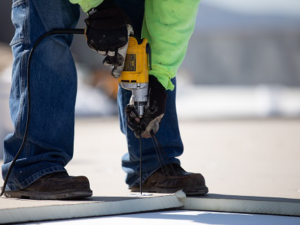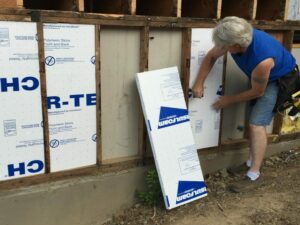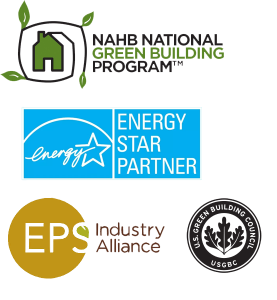What differentiates one rigid foam insulation from another?
Building design and construction professionals can select from several rigid foam insulations, all of which perform well in helping buildings retain or keep out heat. Yet, there are important factors to consider when evaluating some of the primary rigid foam products, like expanded polystyrene (EPS), extruded polystyrene (XPS) and polyisocyanurate (polyiso). Beyond product chemistry and manufacturing methods, two of the key differences among these materials are:
- Insulating performance per unit of measure, and
- Long-term thermal resistance (LTTR).
Insulating performance per unit of measure A common way to compare various insulations is R-value per inch. While such a figure demonstrates a material’s physical ability to impede heat transfer, it is of limited use when specifying insulation since performance vs. cost is the real driver in many architectural product decisions. To use a cliché, “what’s the bang for the buck?” If one looks at the R-value obtained per dollar spent, EPS rates highest. This property becomes more important once designers realize that insulation suffers from the ‘law of diminishing returns’ – additional insulation, beyond a design optimum, results in a very small net increases in energy savings.
Long-term thermal resistance (LTTR) Specifiers often focus on an insulation’s published R-value, yet might not realize that this figure is the initial value at time of manufacture. Many insulations are subject to R-value degradation over the product’s time in service. This is crucial as a drop in performance over time means higher heating and cooling costs over the life of the building. EPS is one of the few rigid foam insulations with a stable thermal resistance throughout its life. In other words, the published R-value of EPS does not decrease over time, compared to other rigid insulations that typically lose up to 20% or more of their insulating capacity during time in service. The reason some rigid foams have declining R values is they use blowing agents that enhance the initial R-value, but diffuse over time and are replaced with air. A simple way to check for this is to review product warranties, which will confirm a stable or declining R-Value over time. EPS manufacturers warrant a stable R-value.
Other factors The degree to which an insulation absorbs water impacts its thermal performance. Compared to some other insulations, rigid foams as a class resist moisture well. However, one misconception is that EPS readily absorbs moisture. However, when one considers that the material is commonly used in food packaging, it’s clear that moisture absorption is actually quite low. This has been demonstrated in real-world and laboratory tests comparing moisture absorption rates. For example, side-by-side testing of EPS and XPS as below grade insulation on a building foundation in St. Paul, Minnesota, showed that EPS outperformed XPS. When the two insulations were removed after being buried under soil for 15 years, the EPS had 4.8% moisture content by volume compared to 18.9% for the XPS. After 30 days of drying time, the EPS moisture level dropped to 0.7%, while the XPS continued to hold 15.7% moisture. These days, design professionals are focusing more on the ‘life-cycle’ effect of moisture on insulation, namely the ability of an insulation to not only resist moisture, but also to readily release any moisture it absorbs. Over dry/moist cycles that grade-application insulations are commonly subjected to, EPS has shown to be the most optimum performing, through its ability to retain the least amount of moisture among rigid insulations. This helps EPS provide a higher R-value over moist-dry cycles that characterize below-grade applications.
Product make-up and applications EPS, XPS and polyiso can all be used throughout the building envelope – roofs, walls and below-grade – in buildings of all sizes and types. The three insulations are recognized as follows:
- EPS is typically white and comes in blocks and panels of various sizes and can be faced or unfazed. Facers enhance physical properties like R-value, fire and moisture protection
- XPS products are commonly offered as pastel or primary colored foams, depending on the brand. The product is most commonly available as board stock of fixed size and thickness.
- Polyiso insulation panels are comprised of foam sandwiched between two facers.
Cost-saving insulation approaches As with other commercial and institutional buildings, in healthcare and educational facilities project teams can minimize rigid foam insulation material and labor costs through careful product specification. Following are two simple ways to help keep insulation costs down.
Better targeting of compressive strength
Insulation manufacturers sometimes market high compressive strength to distinguish their products. As a result, rigid foam insulation is often over-engineered in under-slab and roof applications. Readily available EPS options run up to 60 psi in compressive strength, and are strong enough for almost all building envelop applications. A testimony to EPS’s compressive strength is its use in applications in roadways and structural earthworks as geofoam, which are specified under ASTM D6817 with tighter tolerances than traditional below-grade insulation applications. The cost of using a higher strength insulation than the application requires, can be substantial. For example, specifying a 100 psi XPS product in a below-grade application when a 40 psi EPS product would suffice, can almost double the material cost.
Simplified installation with tapered roof blocks
Building professionals often create positive slopes on flat roof deck assemblies using insulation. Because they are only available in relatively thin sheets, most rigid foam insulations require stacking several layers to build up the desired slope, costing a lot of labor time and material. EPS, on the other hand, is available in individual tapered panels up to 40 inches thick. Some manufacturers have the ability to pre-cut EPS blocks into any slope 1/16 inch or greater and in virtually any custom shape to accommodate roof crickets, saddles, valleys, and ridges, along with all types of drainage systems and layouts. Since fewer separate pieces are needed, building up a slope with tapered EPS blocks requires less on-site material handling and cutting and thus installs much faster. Using tapered EPS can reduce roof insulation costs up to 30% compared to other rigid foam products.
Composite insulation
EPS and polyiso are commonly used in many roofing assemblies, and now manufacturers are producing composite panels that combine these two materials. The EPS provides a lightweight, insulating and resilient foam insulation, while the polyiso serves as an insulating cover board for enhanced durability. Some composite products, such as the InsulFoam® HD Composite panel, carry a UL Class A fire rating for both combustible and non-combustible decks, and are compatible with a range of roofing membranes – including EPDM, TPO, PVC, CSPE, and low-sloped, built-up and modified bitumen membrane systems. As many low-rise healthcare facilities and some schools have wood roof decks, such rated products provide an easy-to-install insulation for fire-rated assemblies.




